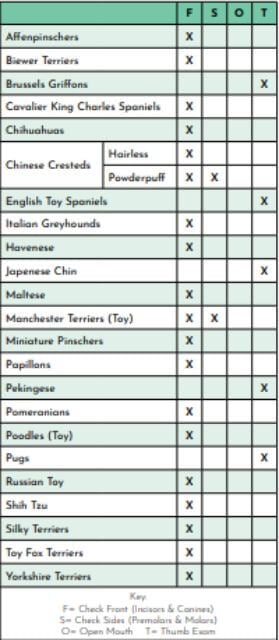


Home » Gentle Hands & Checking Bites On Toy Breeds

Once all the dogs in your class have gone around together, the first dog in the line will be placed on the table for an exam, which includes checking the bite. If you are second in line, be ready to place your dog on the table as soon as the other dog starts his down and back or diagonal. If you are the only entry in your class, after going around the ring, go ahead and place you dog on the table.
Hopefully, you have done your work to prepare for this experience by attending training classes, entered a match, or entered a 4-6 Beginner Puppy event. These experiences are excellent to prepare your dog for this examination by the judge.
Also, early training should include: gaiting your dog and placing your dog on the table; having other people go over your dog; and having your dog used to opening his or her mouth. Your dog should think of this experience as positive. Offer a treat or bait to enforce this procedure. Actually, make it a part of your daily routine to put hands all over your dog and get him or her used to the exam and allowing you to show the bite. All Toy dogs are examined on the table.
Oral exams have four categories and combinations. These categories are:
The chart below is typically used, and most judges have this chart with their Standards for each breed.

Now when you have your dog on the table at the show, we hope your judge approaches the table slowly and uses no abrupt movements. The dog needs to be aware someone is approaching.
The head will be the first to be examined, looking at the skull, top of skull, ear set, eyes, expression, stop, jawline, and expression. At this time, the judge may ask you to show the bite or he might wait until the end of the exam. Having the owner or handler show the bite helps to prevent transfer of germs from mouth to mouth. Show the bite as best you can, and hopefully, prior training makes this flow smoothly.
At the time the judge is examining the head of your exhibit, please refrain from putting your hands in front of the head or offering bait. Move your hands so that the judge has a clear view of the head.
After examining the head, the judge will move to the side to check the chest, shoulders, topline, and legs, including bones and muscles. Then the judge will check tail set, rear, hocks, thighs, and legs. Be prepared to work with the judge to be sure they can clearly see.
Judges develop methods to go about the process of evaluating dogs. Exhibitors need to be tolerant and be in tune. Coated breeds require a more hands-on exam to verify what is under the coat. Breeds including Chihuahuas, Miniature Pinschers, and Toy Fox Terriers have quicker exams, as the eye allows you to see the dog. Judges develop an eye that enables them to sum up a dog instantly. This skill develops and improves with time and experience.
In summary, exhibitors and handlers, be sure your dog is trained and ready for the ring. Also, remember to exercise your dog and potty them before ring time! And remember that the judge is on a time frame and schedule, so be on time, have the proper arm band on, listen to instructions, and by all means have help lined up in advance if you have more than one entry.
We all must remember, Toy dogs are small but they think they are big. Approach slowly, be gentle, do not use baby talk, and do not loom over them or put your face in front of them.
If a dog resists an exam, step back and allow them to restack; and if that does not help, go to the back and examine and then return to the front. Another thing you can do is allow the handler or exhibitor to remove the dog from the table and complete a down and back and then return to the table. If all efforts do not work, the judge will have to excuse your dog for failure to be examined. Again, this is why training ahead of time is so important and necessary.
On the table, judges, take a little time with new exhibitors or new exhibits that are entered for the first time or first weekend. After all, this is supposed to be fun and inviting. If we want our sport to be maintained, grow, and prosper, we all need to be kind, friendly, and flexible.
